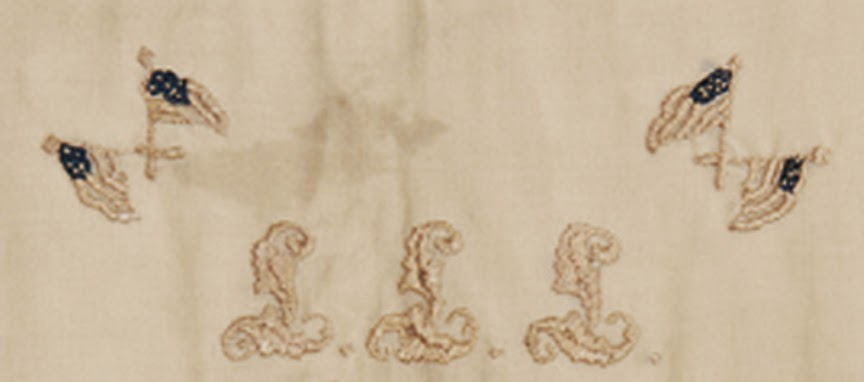Log Cabin quilt inscribed in the center 1865
79" x 80"
Collection of Minnesota Historical Society
The Minnesota Historical Society has photos of this Civil War quilt in their online collections page. It is dated May, 1865, a month after the war ended. If this is indeed the date it was made, it is one of the earliest surviving, date-inscribed Log Cabin quilts.
The fabrics are wool.
The inscription: "L.L.L. #352 Du Quoin, Illinois. May. 1865"
See the quilt at their website here:
"L.L.L. are presumably the quiltmaker's initials, but the rest of the inscription remains a mystery."The museum's catalog entry links the initials to a woman's Civil War organization:
"The Loyal Ladies League was an auxiliary of the G.A.R. Quilt belonged to Watson I. Lamson, who was in the Civil War. The quilt was made by Lucy Lee Lamson (1820-1887) in Homer, Minnesota (Winona County)."
I found a Lucy Ann Lee Lamson, born in 1820 in Mount Washington, Massachusetts, who died in 1888 in Homer, Winona County, Minnesota. Her husband was William Lamson. She had three sons: Adelbert Arthur, born in 1842, Watson Irving, born in 1844, and Livingston, born in 1846. Her last child Mary, born in 1847, died at about 7 years old.
The family left Massachusetts in 1851 for Rockford, Illinois, where they lived for three years before moving to Winona County. She and members of her family are buried in the Woodlawn Cemetery in the town of Winona.
The area around Winona is known for its scenic landscape.
Winona is the red arrow at the top of this Google map.
Lucy and her family lived near this Mississippi River town for much of their lives after spending three years in Rockford (the middle arrow.) The quilt refers to Du Quoin, Illinois, the red pin at the bottom of the map, south of St. Louis.
There are several questions associated with this quilt:
- Did LLL stand for Lucy Lee Lamson or Loyal Ladies League?
- What did Lucy Lamson have to do with Du Quoin, Illinois?
- Why would a quilt made in Minnesota refer to a town in Southern Illinois that is over 500 miles away?
We can discuss the last question first. I just don't think the quilt was made in 1865.
I would guess the tan flag stripes and the initials were once red.
The thread has faded over the years in a manner typical of
late-19th century synthetic red dyes.
causes me to think that the piece is a late-19th-century quilt.
We find several Log Cabin quilts dated in the 1870s.
This silk example is inscribed 1879,
again in faded thread.
Wool log cabin dated 1876 in cross-stitch by Susan Messenger
Patriotic log cabin dated 1876 from
the Helen Louise Allen Textile Collection at the University of Wisconsin,
perhaps made for the Centennial celebration.
Silk log cabin dated 1887
The central panel on the LLL quilt is embroidered
in a very typical 1880s style
with a graphic flair often seen on crazy quilts.
Was the date above once bright red?
Here's a red that's lasted, probably red wool
rather than silk or cotton.
The Minnesota Historical Society also has questions about that 1865 date. At one place in the catalog they list the creation date of the quilt:
" Not earlier than 1883 - Not later than 1892."
They base the estimated date 1883-1892 on the year for the founding of The Loyal Ladies League, which "was organized as an auxiliary of the GAR in Denver, Colorado in 1883." More about that organization next week. Where they get the late date of 1892 I can't figure out.
Lucy Lamson died in April, 1887 or 1888, so she might have made it during the '80s, but I'm beginning to doubt that she put a stitch into it.
More on what LLL could mean next week.


















































